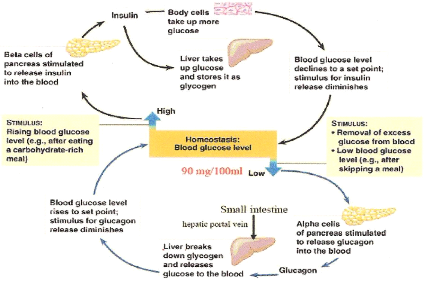CHAPTER I. LITERATURE REVIEW
I.1.Generalities on diabetes mellitus
I.1.1. Glucose
metabolism
I.1.1.1. Digestion and absorption of carbohydrates
Dietary polysaccharides are hydrolysed in the
gastrointestinal tract by the enzyme alpha amylase to produce oligosaccharides
and disaccharides. The resulting disaccharides are further hydrolysed by alpha
glucosidase enzymes to produce glucose and other monosaccharides as shown
below
Fig. 2.1. Digestion of polysaccharides by
á-amylase and á-glucosidases
Dietary (polysaccharide)
á-glucosidases
Glucose, fructose and galactose
Oligosaccharides
and disaccharides
á-Amylase
Glucose and other monosaccharides (fructose and galactose)
resulting from digestion of carbohydrates are absorbed through the small
intestine into the hepatic portal vein. This results in elevation of the
postprandial blood glucose level (Hannan et al.,
2007).
I.1.1.2. Role of the pancreas in
glucose metabolism
The pancreas plays a primary role in the metabolism of glucose
by secreting the hormones, insulin and glucagon (Figure 1.). Elevated
postprandial blood glucose level stimulates pancreatic beta cells to secrete
insulin which then facilitates the entry of glucose into the muscle and adipose
tissues, thereby clearing excess glucose from the circulation. Insulin also
stimulates the processes of glycolysis (catabolism of glucose) and glycogenesis
(synthesis of glycogen from glucose) and inhibits both hepatic gluconeogenesis
and glycogenolysis thereby reducing the hepatic glucose output (kimber
et al., 2006). The actions of insulin are opposed by
glucagon, a hormone produced by the pancreatic alpha cells when the blood
glucose level tends to be low. Glucagon inhibits glycogenesis and stimulates
both gluconeogenesis and glycogenolysis which releases blood glucose into the
blood circulation thereby raising the blood glucose level (kimber
et al., 2006).
 Figure
1: The role of the pancreas in glucose homeostasis (Cheng and Fantus,
2005) Figure
1: The role of the pancreas in glucose homeostasis (Cheng and Fantus,
2005)
I.1.1.3. Metabolic actions
of insulin
Metabolic actions of insulin result from its interaction with
the insulin receptor (IR) found in all insulin responsive target cells (liver,
muscle and adipose tissue). Insulin binds to the alpha-subunit of IR and
activates the intrinsic tyrosine kinase activity of the beta-subunit of the
receptor. Activated IR results in the subsequent phosphorylation of
intracellular substrates including insulin receptor substrates,
phosphatidylinositol (PI) 3-kinase, and protein kinase B (PKB). Normal insulin
action leads to increased glycogen synthesis, glucose transport, and
lipogenesis, and decreased gluconeogenesis, glycogenolysis, and lipolysis
(Cheng and Fantus, 2005).
I.1.2. Prevalence of
diabetes mellitus
Chronic non transmissible diseases are diseases that have
evolved for many years and they require long term management. These diseases
include diabetes, cardiovascular diseases, high blood pressure and cancer. They
are the direct consequences of our daily behavioral activities such as lack of
physical activities, obesity, malnutrition, cigarette smoking and alcoholism
(Craig et al., 2009). Diabetes mellitus an example of
such disease whose prevalence among adults (aged 20-79 years) was estimated to
rise from 6.4%, affecting 285 million adults, in 2010, to 7.7%, affecting 439
million adults by 2030. Between 2010 and 2030, there was to be a 69% increase
in numbers of adults with diabetes in developing countries and a 20% increase
in developed countries (Shaw et al., 2010). In
Cameroon, recent estimations situated the prevalence rate at 4,3%, with an
increased prevision of 4,7% by the year 2025 (Shaw et al.,
2010). This epidemic has been attributed to high fat/ high sugar
intake in modern diet including sedentary lifestyle and lack of physical
activity (Jatin et al., 2011).
| 


